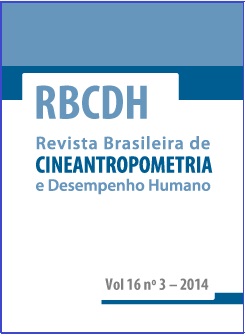Fatores determinantes do rendimento quando o Counter Movement Jump se realiza em fadiga aguda
DOI:
https://doi.org/10.1590/1980-0037.2014v16n3p316Resumo
Este estudio tuvo como objetivo analizar los cambios que se dan en los parámetros cinético-temporales y la actividad electromiográfica de músculos de miembro inferior durante la ejecución de Counter movement Jumps (CMJ) máximos con y sin fatiga a los efectos de explicar los cambios de rendimiento en ambas situaciones. Se registró la fuerza vertical de cincuenta saltos realizados por diez deportistas de sexo masculino antes y después de un protocolo de fatiga. Se obtuvieron registros de electromiografía de superficie para seis músculos de miembro inferior y se analizó el nivel de activación y coordinación intermuscular. Para los análisis se consideraron por separado los tiempos de trabajo mecánico negativo y positivo. En ambas condiciones el curso temporal de distribución de fuerza es más importante para la performance que cualquier parámetro instantáneo. El tiempo de trabajo externo negativo fue significativamente menor en condición de fatiga. Los análisis electromiográficos mostraron un aumento en el nivel de activación de todos los músculos estudiados e importantes cambios en la secuencia de activación. Las variables cinético-temporales puntuales no resultaron buenos predictores de la altura del salto. Cuando el CMJ es ejecutado sin fatiga, un alto valor de estado activo favorece el trabajo positivo. Durante la fatiga, una compensación parcial del rendimiento podría darse por el aumento de actividad de los elementos contráctiles. Sin embargo, la secuencia de activación sufre importantes cambios, de manera que los cambios en rendimiento estarían asociados principalmente con la disminución en la capacidad de trasmitir la potencia en sentido proximal distal.
Downloads
Publicado
Edição
Seção
Licença

Direitos Autorais para artigos publicados nesta revista são do autor, com direitos de primeira publicação para a revista. Em virtude da aparecerem nesta revista de acesso público, os artigos são de uso gratuito, com atribuições próprias, em aplicações educacionais e não-comerciais, desde que seja dada a atribuição. Esta obra foi licenciada com uma Licença Creative Commons Atribuição 4.0 Internacional - CC BY


